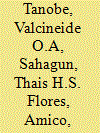| Srl | Item |
| 1 |
ID:
130737


|
|
|
|
|
| Publication |
2014.
|
| Summary/Abstract |
Increasing environmental concern along with the drive to find substitutes for synthetic fibers and value added applications for low cost and renewable plant fibers have led to the development of composites based on biomaterials. One of the drawbacks encountered in such exercise is the lack of adhesion between the incorporated plant fibers and synthetic polymeric matrices. Such drawback can be reduced by appropriate treatment of fibers. This paper describes the chemical treatments used on sponge gourd (Luffa cylindrica) fibers of Brazil to prepare their composites with polyester resin. Production of short fiber-polymer composite as well as mat-polyester composites is presented here. Characterization of the composites in respect of evaluation of density, water absorption, thermalstability, tensile properties and impact strength were made and the results are discussed. Observed impact strengthand tensile properties are discussed based on the fractographic studies of the composites.
|
|
|
|
|
|
|
|
|
|
|
|
|
|
|
|
| 2 |
ID:
130746


|
|
|
|
|
| Publication |
2014.
|
| Summary/Abstract |
It is believed that addition of small amount of nanoclays in the neat epoxy and fiber reinforced epoxy composite system can improve the mechanical properties. The mechanical properties of most of polymer matrix composites are sensitive to testing rate. However, most of the researches were concentrated on the behavior of the polymer
matrix composites at high strain rates. The present research work is to investigate the role of clay on neat epoxy and glass-fiber reinforced epoxy composites, at low strain rates. The clay in terms of 1.5 wt%, 3 wt%, and 5 wt% are dispersed in the epoxy resin using mechanical stirring followed by sonication process. The corresponding glass/epoxy nanocomposites are prepared by impregnating the clay epoxy mixture by hand lay-up process. Characterization of the nanoclay is done by X-ray diffraction and Scanning Electron Microscopy. Tensile stress-strain curves are obtained at strain rates of 10-4 s-1, 10-3 s-1, 10-2 s-1, and 10-1 s-1 by a hydraulic machine reporting that, even at low strain rates, the longitudinal strength and stiffness increase as strain rate increases for all clay loadings. It is observed that the tensile modulus increases as the clay loading increases for both epoxy and glass/epoxy nanocomposites. It is also noticed that the longitudinal tensile strength decreases as the clay loading increases. The failed specimens show marked changes in the fracture surface with increased strain rate. Scanning electron microscopy is used to study the fiber/matrix/clay adhesion in fracture surfaces.
|
|
|
|
|
|
|
|
|
|
|
|
|
|
|
|